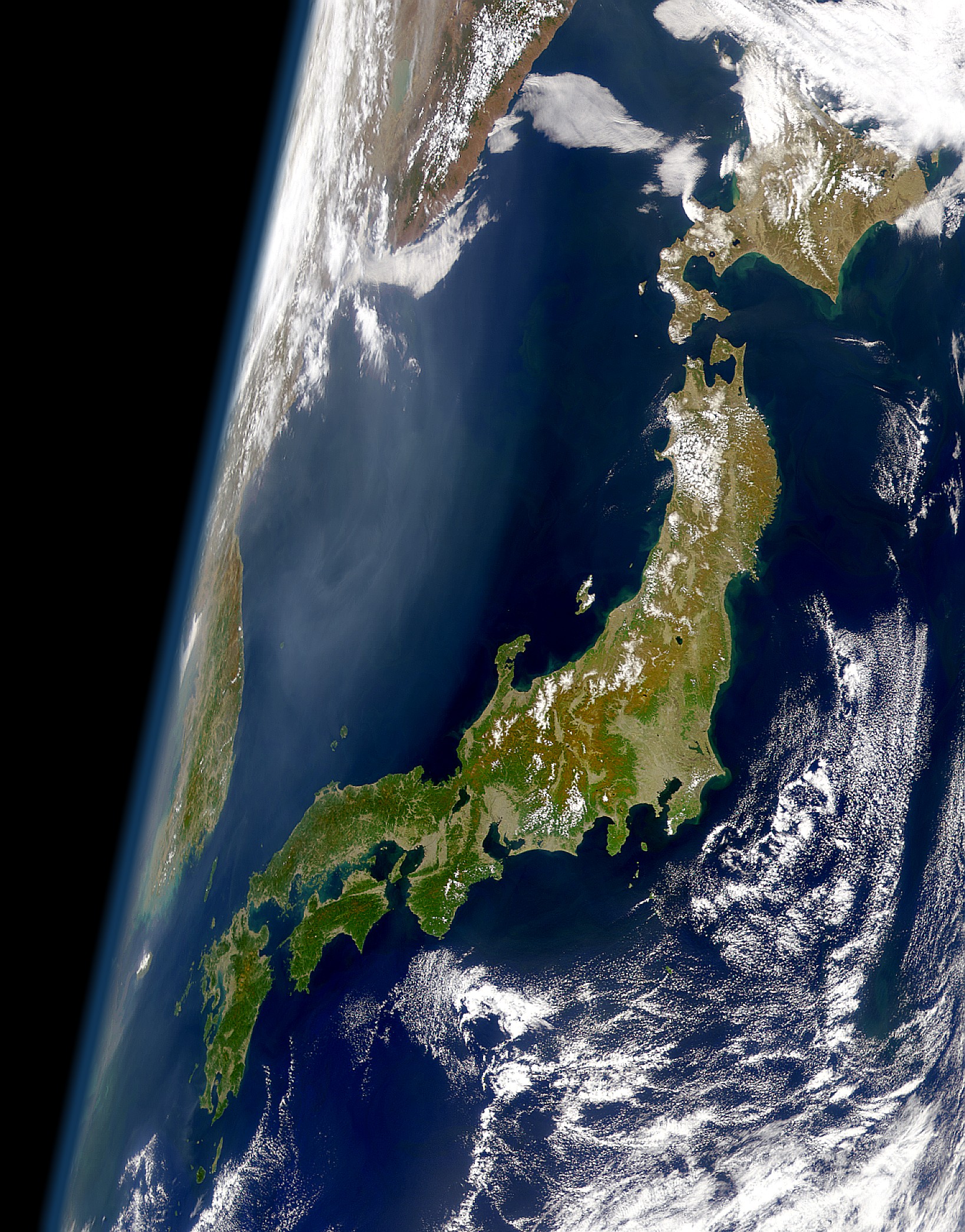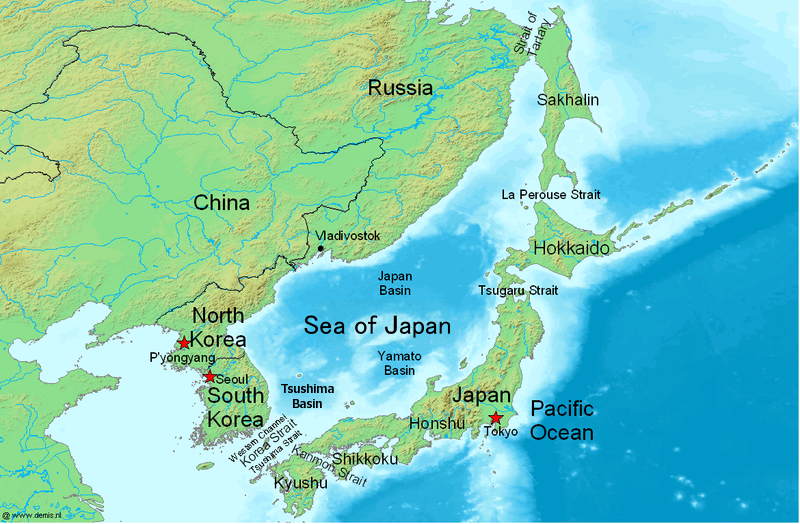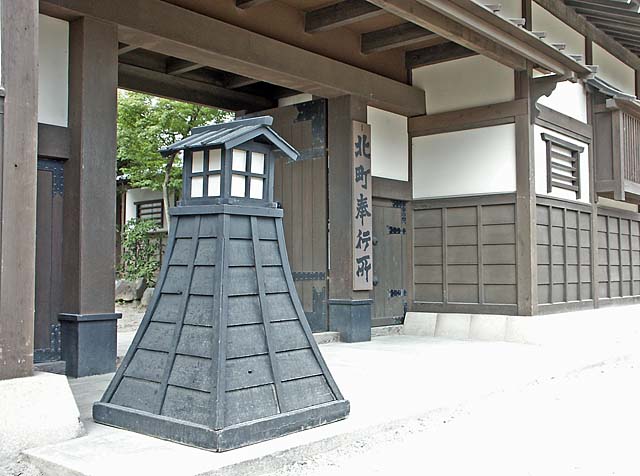|
Niigata Bugyō
were officials of the Tokugawa shogunate in Edo period Japan. Appointments to this prominent office were usually '' fudai daimyōs'', but this was amongst the senior administrative posts open to those who were not ''daimyōs''.Beasley, William G. (1955). ''Select Documents on Japanese Foreign Policy, 1853–1868'', p. 325. Conventional interpretations have construed these Japanese titles as "commissioner" or "overseer" or "governor". The city of Niigata is the largest city in what was once Echigo Province. It lies on the northwest coast of Honshū, the largest island of Japan. The port on the Sea of Japan faces west towards Sado Island. In 1858, Niigata was designated as one of the five ports to be opened for international trade in the Treaty of Amity and Commerce between Japan and the United States; however, the shallow water level in the port delayed the actual opening to foreign ships until 1869. This '' bakufu'' tile identifies an official responsible for administration ... [...More Info...] [...Related Items...] OR: [Wikipedia] [Google] [Baidu] |
Tokugawa Shogunate
The Tokugawa shogunate (, Japanese 徳川幕府 ''Tokugawa bakufu''), also known as the , was the military government of Japan Japan ( ja, 日本, or , and formally , ''Nihonkoku'') is an island country in East Asia. It is situated in the northwest Pacific Ocean, and is bordered on the west by the Sea of Japan, while extending from the Sea of Okhotsk in the no ... during the Edo period from 1603 to 1868.Louis-Frédéric, Nussbaum, Louis-Frédéric. (2005)"''Tokugawa-jidai''"in ''Japan Encyclopedia'', p. 978.Nussbaum"''Edo-jidai''"at p. 167. The Tokugawa shogunate was established by Tokugawa Ieyasu after victory at the Battle of Sekigahara, ending the civil wars of the Sengoku period following the collapse of the Ashikaga shogunate. Ieyasu became the ''shōgun,'' and the Tokugawa clan governed Japan from Edo Castle in the eastern city of Edo (Tokyo) along with the ''daimyō'' lords of the ''samurai'' class.Nussbaum"Tokugawa"at p. 976. The Tokugawa shogunate organized ... [...More Info...] [...Related Items...] OR: [Wikipedia] [Google] [Baidu] |
Edo Period
The or is the period between 1603 and 1867 in the history of Japan, when Japan was under the rule of the Tokugawa shogunate and the country's 300 regional ''daimyo''. Emerging from the chaos of the Sengoku period, the Edo period was characterized by economic growth, strict social order, isolationist foreign policies, a stable population, perpetual peace, and popular enjoyment of arts and culture. The period derives its name from Edo (now Tokyo), where on March 24, 1603, the shogunate was officially established by Tokugawa Ieyasu. The period came to an end with the Meiji Restoration and the Boshin War, which restored imperial rule to Japan. Consolidation of the shogunate The Edo period or Tokugawa period is the period between 1603 and 1867 in the history of Japan, when Japan was under the rule of the Tokugawa shogunate and the country's regional ''daimyo''. A revolution took place from the time of the Kamakura shogunate, which existed with the Tennō's court, to th ... [...More Info...] [...Related Items...] OR: [Wikipedia] [Google] [Baidu] |
Fudai Daimyō
was a class of ''daimyō'' (大名) in the Tokugawa Shogunate (徳川幕府) of Japan who were hereditary vassals of the Tokugawa before the Battle of Sekigahara. ''Fudai daimyō'' and their descendants filled the ranks of the Tokugawa administration in opposition to the ''tozama daimyō'' and held most of the power in Japan during the Edo period. Origins ''Fudai daimyōs'' originated from the families and clans who had served the prominent Tokugawa clan before its rise to national primacy during the Azuchi–Momoyama period in the late Sengoku period, including the Honda, Sakai, Sakakibara, Ii, Itakura, and Mizuno clans. A number of other clans which were not retainers of the Tokugawa before the Azuchi–Momoyama period also came to be counted as ''fudai'', such as the Ogasawara and the Doi. Honda Tadakatsu, Sakakibara Yasumasa, Sakai Tadatsugu, and Ii Naomasa — Tokugawa Ieyasu's " Four Great Generals" — were all pre-Edo period ''fudai'' who went on to become '' ... [...More Info...] [...Related Items...] OR: [Wikipedia] [Google] [Baidu] |
Daimyō
were powerful Japanese magnates, feudal lords who, from the 10th century to the early Meiji period in the middle 19th century, ruled most of Japan from their vast, hereditary land holdings. They were subordinate to the shogun and nominally to the emperor and the '' kuge''. In the term, means 'large', and stands for , meaning 'private land'. From the '' shugo'' of the Muromachi period through the Sengoku to the ''daimyo'' of the Edo period, the rank had a long and varied history. The backgrounds of ''daimyo'' also varied considerably; while some ''daimyo'' clans, notably the Mōri, Shimazu and Hosokawa, were cadet branches of the Imperial family or were descended from the ''kuge'', other ''daimyo'' were promoted from the ranks of the samurai, notably during the Edo period. ''Daimyo'' often hired samurai to guard their land, and they paid the samurai in land or food as relatively few could afford to pay samurai in money. The ''daimyo'' era ended soon after the Meiji R ... [...More Info...] [...Related Items...] OR: [Wikipedia] [Google] [Baidu] |
Niigata, Niigata
is a city located in the northern part of Niigata Prefecture (). It is the capital and the most populous city of Niigata Prefecture, and one of the cities designated by government ordinance of Japan, located in the Chūbu region of Japan. It is the most populous city on the west coast of Honshu, and the second populous city in Chūbu region after Nagoya. It faces the Sea of Japan and Sado Island. , the city had an estimated population of 779,049, and a population density of 1,072 persons per km2. The total area is . Greater Niigata, the Niigata Metropolitan Employment Area, has a GDP of US$43.3 billion as of 2010. It is the only government-designated city on the west coast of Honshu. It has the greatest habitable area of cities in Japan (). It is designated as a reform base for the large scale agriculture under () initiatives. Overview Niigata was one of the cities incorporated by the legislation effective on April 1, 1889 (Meiji 22). With a long history as a port town, Niigat ... [...More Info...] [...Related Items...] OR: [Wikipedia] [Google] [Baidu] |
Echigo Province
was an old provinces of Japan, old province in north-central Japan, on the shores of the Sea of Japan. It bordered on Uzen Province, Uzen, Iwashiro Province, Iwashiro, Kōzuke Province, Kōzuke, Shinano Province, Shinano, and Etchū Province, Etchū Provinces.Louis-Frédéric, Nussbaum, Louis-Frédéric. (2005). "''Echigo''" in . It corresponds today to Niigata Prefecture, minus the island of Sado, Niigata, Sado. Its abbreviated form name was , with Echizen Province, Echizen and Etchū Province, Etchū Provinces. Under the ''Engishiki'' classification system, Echigo was ranked as one of the 35 "superior countries" (上国) in terms of importance, and one of the 30 "far countries" (遠国) in terms of distance from the capital. Echigo and Kōzuke Province were known as the Jōetsu region. History In the late 7th century, during the reign of Emperor Monmu, the ancient province of was divided into three separate provinces: Echizen Province, Echizen, Etchū Province, Etchū, ... [...More Info...] [...Related Items...] OR: [Wikipedia] [Google] [Baidu] |
Honshū
, historically called , is the largest and most populous island of Japan. It is located south of Hokkaidō across the Tsugaru Strait, north of Shikoku across the Inland Sea, and northeast of Kyūshū across the Kanmon Straits. The island separates the Sea of Japan, which lies to its north and west, from the North Pacific Ocean to the south and east. It is the seventh-largest island in the world, and the second-most populous after the Indonesian island of Java. Honshu had a population of 104 million , constituting 81.3% of the entire population of Japan, and is mostly concentrated in the coastal areas and plains. Approximately 30% of the total population resides in the Greater Tokyo Area on the Kantō Plain. As the historical center of Japanese cultural and political power, the island includes several past Japanese capitals, including Kyōto, Nara and Kamakura. Much of the island's southern shore forms part of the Taiheiyō Belt, a megalopolis that spans several o ... [...More Info...] [...Related Items...] OR: [Wikipedia] [Google] [Baidu] |
Sea Of Japan
The Sea of Japan is the marginal sea between the Japanese archipelago, Sakhalin, the Korean Peninsula, and the mainland of the Russian Far East. The Japanese archipelago separates the sea from the Pacific Ocean. Like the Mediterranean Sea, it has almost no tides due to its nearly complete enclosure from the Pacific Ocean. This isolation also affects faunal diversity and salinity, both of which are lower than in the open ocean. The sea has no large islands, bays or capes. Its water balance is mostly determined by the inflow and outflow through the straits connecting it to the neighboring seas and the Pacific Ocean. Few rivers discharge into the sea and their total contribution to the water exchange is within 1%. The seawater has an elevated concentration of dissolved oxygen that results in high biological productivity. Therefore, fishing is the dominant economic activity in the region. The intensity of shipments across the sea has been moderate owing to political issues, but it ... [...More Info...] [...Related Items...] OR: [Wikipedia] [Google] [Baidu] |
Sado Island
is a city located on in Niigata Prefecture, Japan. Since 2004, the city has comprised the entire island, although not all of its total area is urbanized. Sado is the sixth largest island of Japan in area following the four main islands and Okinawa Island (excluding the Northern Territories). As of March 1, 2022, the city has an estimated population of 49,897 and a population density of 58.3 persons per square kilometre. The total area is 855.69 km2. History Political formation of the island The large number of pottery artifacts found near Ogi in the South of the island demonstrate that Sado was populated as early as the Jōmon period. The '' Nihon Shoki'' mentions that Mishihase people visited the island in 544 (although it is unknown whether Tungusic people effectively came). The island formed a distinct province, the Sado Province, separate from the Echigo province on Honshū, at the beginning of the 8th century. At first, the province was a single ''gun'' (distric ... [...More Info...] [...Related Items...] OR: [Wikipedia] [Google] [Baidu] |
Treaty Of Amity And Commerce (United States-Japan)
Treaty of Amity and Commerce may refer to: * Treaty of Amity and Commerce (United States–France) (1778) * Treaty of Amity and Commerce (United States–Dutch Republic), a 1782 United States treaty * Treaty of Amity and Commerce (United States–Sweden) (1783) * Treaty of Amity and Commerce (Prussia–United States) (1785) * Treaty of Amity and Commerce (United States-Siam) or Siamese-American Treaty of Amity and Commerce (1833) * Treaty of Amity and Commerce (U.K.-Siam) or Bowring Treaty (1855) * Treaty of Amity and Commerce (U.K.-Japan) or Anglo-Japanese Treaty of Amity and Commerce (1858) * Treaty of Amity and Commerce (France-Japan) (1858) * Treaty of Amity and Commerce (United States–Japan) or Harris Treaty (1858) * Treaty of Amity and Commerce (Prussia–Japan) (1861) * Treaty of Amity and Commerce (United States-Joseon/Korea) or Joseon-American Treaty of Amity and Commerce (1882) * Treaty of Amity and Commerce (China-Macau) or Sino-Portuguese Treaty ceding (1887) ... [...More Info...] [...Related Items...] OR: [Wikipedia] [Google] [Baidu] |
Bakufu
, officially , was the title of the military dictators of Japan during most of the period spanning from 1185 to 1868. Nominally appointed by the Emperor, shoguns were usually the de facto rulers of the country, though during part of the Kamakura period, shoguns were themselves figureheads, with real power in hands of the Shikken of the Hōjō clan. The office of shogun was in practice hereditary, though over the course of the history of Japan several different clans held the position. The title was originally held by military commanders during Heian period in the eighth and ninth centuries. When Minamoto no Yoritomo gained political ascendency over Japan in 1185, the title was revived to regularize his position, making him the first shogun in the usually understood sense. The shogun's officials were collectively referred to as the ; they were the ones who carried out the actual duties of administration, while the Imperial court retained only nominal authority.Beasley, William G. ... [...More Info...] [...Related Items...] OR: [Wikipedia] [Google] [Baidu] |
Bugyō
was a title assigned to ''samurai'' officials during the feudal period of Japan. ''Bugyō'' is often translated as commissioner, magistrate, or governor, and other terms would be added to the title to describe more specifically a given official's tasks or jurisdiction. Pre-Edo period In the Heian period (794–1185), the post or title of ''bugyō'' would be applied only to an official with a set task; once that task was complete, the officer would cease to be called ''bugyō''. However, in the Kamakura period (1185–1333) and later, continuing through the end of the Edo period (1603–1868), posts and title came to be created on a more permanent basis.Kinihara, Misako''The Establishment of the Tosen-bugyō in the Reign of Ashikaga Yoshinori'' (唐船奉行の成立 : 足利義教による飯尾貞連の登用) Tokyo Woman's Christian University. ''Essays and S.tudies''. Abstract. Over time, there came to be 36 ''bugyō'' in the bureaucracy of the Kamakura shogunate. In 14 ... [...More Info...] [...Related Items...] OR: [Wikipedia] [Google] [Baidu] |






